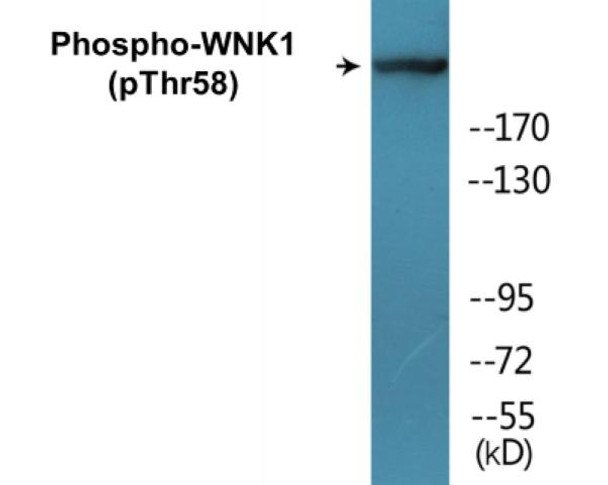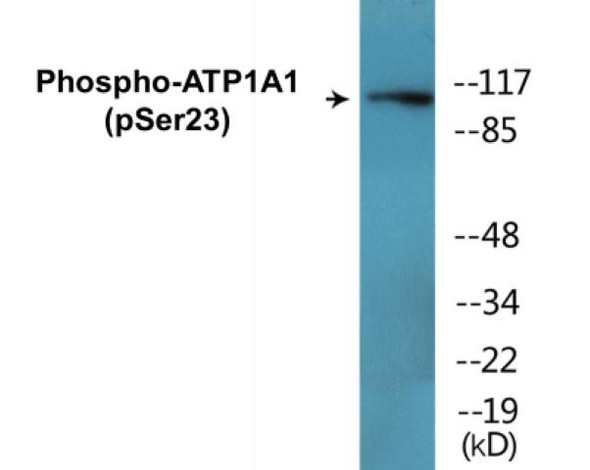WNK1 (Phospho-Thr58) Colorimetric Cell-Based ELISA Kit
- SKU:
- CBCAB01255
- Product Type:
- ELISA Kit
- ELISA Type:
- Cell Based Phospho Specific
- Reactivity:
- Human
- Mouse
- Rat
- Detection Method:
- Colorimetric
Description
WNK1 (Phospho-Thr58)Colorimetric Cell-Based ELISA Kit
The WNK1 Phospho-Thr58 Colorimetric Cell-Based ELISA Kit from AssayGenie is a powerful tool for the detection of phosphorylated WNK1 at threonine 58 in cell lysates. This kit offers high sensitivity and specificity, allowing for accurate and reproducible results in a variety of research applications.WNK1, a serine/threonine kinase, plays a crucial role in regulating ion transport and maintaining cellular homeostasis. Phosphorylation of WNK1 at threonine 58 has been implicated in various physiological processes, including blood pressure regulation and cell proliferation.
Dysregulation of WNK1 signaling has been associated with diseases such as hypertension and neurological disorders, making it a valuable target for therapeutic interventions.The WNK1 Phospho-Thr58 Colorimetric Cell-Based ELISA Kit offers a convenient and reliable method for studying WNK1 signaling pathways and identifying potential therapeutic targets. With its user-friendly protocol and high-quality reagents, this kit is a valuable tool for researchers studying the role of WNK1 in health and disease.
| Product Name: | WNK1 (Phospho-Thr58) Colorimetric Cell-Based ELISA |
| Product Code: | CBCAB01255 |
| ELISA Type: | Cell-Based |
| Target: | WNK1 (Phospho-Thr58) |
| Reactivity: | Human, Mouse, Rat |
| Dynamic Range: | > 5000 Cells |
| Detection Method: | Colorimetric 450 nm |
| Format: | 2 x 96-Well Microplates |
The WNK1 (Phospho-Thr58) Colorimetric Cell-Based ELISA Kit is a convenient, lysate-free, high throughput and sensitive assay kit that can detect WNK1 protein phosphorylation and expression profile in cells. The kit can be used for measuring the relative amounts of phosphorylated WNK1 in cultured cells as well as screening for the effects that various treatments, inhibitors (ie. siRNA or chemicals), or activators have on WNK1 phosphorylation.
Qualitative determination of WNK1 (Phospho-Thr58) concentration is achieved by an indirect ELISA format. In essence, WNK1 (Phospho-Thr58) is captured by WNK1 (Phospho-Thr58)-specific primary (1ø) antibodies while the HRP-conjugated secondary (2ø) antibodies bind the Fc region of the 1ø antibody. Through this binding, the HRP enzyme conjugated to the 2ø antibody can catalyze a colorimetric reaction upon substrate addition. Due to the qualitative nature of the Cell-Based ELISA, multiple normalization methods are needed:
| 1. | A monoclonal antibody specific for human GAPDH is included to serve as an internal positive control in normalizing the target absorbance values. |
| 2. | Following the colorimetric measurement of HRP activity via substrate addition, the Crystal Violet whole-cell staining method may be used to determine cell density. After staining, the results can be analysed by normalizing the absorbance values to cell amounts, by which the plating difference can be adjusted. |
| Database Information: | Gene ID: 65125, UniProt ID: Q9H4A3, OMIM: 145260/605232, Unigene: Hs.356604/Hs.656067 |
| Gene Symbol: | WNK1 |
| Sub Type: | Phospho |
| UniProt Protein Function: | WNK1: a serine-threonine protein kinase that controls sodium and chloride ion transport. May regulate the activity of the thiazide-sensitive Na-Cl cotransporter SLC12A3 by phosphorylation. May also play a role in actin cytoskeletal reorganization. |
| UniProt Protein Details: | Protein type:EC 2.7.11.1; Protein kinase, Other; Kinase, protein; Protein kinase, Ser/Thr (non-receptor); Other group; Wnk family Chromosomal Location of Human Ortholog: 12p13.3 Cellular Component: cytoplasm Molecular Function:protein serine/threonine kinase activity; protein binding; chloride channel inhibitor activity; protein kinase inhibitor activity; ATP binding; phosphatase binding Biological Process: regulation of cellular process; peptidyl-threonine phosphorylation; negative regulation of protein kinase activity; neuron development; ion transport; protein amino acid phosphorylation Disease: Neuropathy, Hereditary Sensory And Autonomic, Type Iia; Pseudohypoaldosteronism, Type Iic |
| NCBI Summary: | This gene encodes a member of the WNK subfamily of serine/threonine protein kinases. The encoded protein may be a key regulator of blood pressure by controlling the transport of sodium and chloride ions. Mutations in this gene have been associated with pseudohypoaldosteronism type II and hereditary sensory neuropathy type II. Alternatively spliced transcript variants encoding different isoforms have been described but the full-length nature of all of them has yet to be determined.[provided by RefSeq, May 2010] |
| UniProt Code: | Q9H4A3 |
| NCBI GenInfo Identifier: | 296453029 |
| NCBI Gene ID: | 65125 |
| NCBI Accession: | Q9H4A3.2 |
| UniProt Secondary Accession: | Q9H4A3,O15052, P54963, Q4VBX9, Q6IFS5, Q86WL5, Q8N673 A1L4B0, C5HTZ5, C5HTZ6, C5HTZ7, H6WZW3, |
| UniProt Related Accession: | Q9H4A3 |
| Molecular Weight: | 2382 |
| NCBI Full Name: | Serine/threonine-protein kinase WNK1 |
| NCBI Synonym Full Names: | WNK lysine deficient protein kinase 1 |
| NCBI Official Symbol: | WNK1 |
| NCBI Official Synonym Symbols: | KDP; PSK; p65; HSN2; HSAN2; PRKWNK1; PPP1R167 |
| NCBI Protein Information: | serine/threonine-protein kinase WNK1; erythrocyte 65 kDa protein; protein kinase with no lysine 1; prostate-derived sterile 20-like kinase; WNK lysine deficient protein kinase 1 isoform; protein phosphatase 1, regulatory subunit 167 |
| UniProt Protein Name: | Serine/threonine-protein kinase WNK1 |
| UniProt Synonym Protein Names: | Erythrocyte 65 kDa protein; p65; Kinase deficient protein; Protein kinase lysine-deficient 1; Protein kinase with no lysine 1; hWNK1 |
| Protein Family: | Serine/threonine-protein kinase |
| UniProt Gene Name: | WNK1 |
| UniProt Entry Name: | WNK1_HUMAN |
| Component | Quantity |
| 96-Well Cell Culture Clear-Bottom Microplate | 2 plates |
| 10X TBS | 24 mL |
| Quenching Buffer | 24 mL |
| Blocking Buffer | 50 mL |
| 15X Wash Buffer | 50 mL |
| Primary Antibody Diluent | 12 mL |
| 100x Anti-Phospho Target Antibody | 60 µL |
| 100x Anti-Target Antibody | 60 µL |
| Anti-GAPDH Antibody | 60 µL |
| HRP-Conjugated Anti-Rabbit IgG Antibody | 12 mL |
| HRP-Conjugated Anti-Mouse IgG Antibody | 12 mL |
| SDS Solution | 12 mL |
| Stop Solution | 24 mL |
| Ready-to-Use Substrate | 12 mL |
| Crystal Violet Solution | 12 mL |
| Adhesive Plate Seals | 2 seals |
The following materials and/or equipment are NOT provided in this kit but are necessary to successfully conduct the experiment:
- Microplate reader able to measure absorbance at 450 nm and/or 595 nm for Crystal Violet Cell Staining (Optional)
- Micropipettes with capability of measuring volumes ranging from 1 µL to 1 ml
- 37% formaldehyde (Sigma Cat# F-8775) or formaldehyde from other sources
- Squirt bottle, manifold dispenser, multichannel pipette reservoir or automated microplate washer
- Graph paper or computer software capable of generating or displaying logarithmic functions
- Absorbent papers or vacuum aspirator
- Test tubes or microfuge tubes capable of storing ≥1 ml
- Poly-L-Lysine (Sigma Cat# P4832 for suspension cells)
- Orbital shaker (optional)
- Deionized or sterile water
*Note: Protocols are specific to each batch/lot. For the correct instructions please follow the protocol included in your kit.
| Step | Procedure |
| 1. | Seed 200 µL of 20,000 adherent cells in culture medium in each well of a 96-well plate. The plates included in the kit are sterile and treated for cell culture. For suspension cells and loosely attached cells, coat the plates with 100 µL of 10 µg/ml Poly-L-Lysine (not included) to each well of a 96-well plate for 30 minutes at 37 °C prior to adding cells. |
| 2. | Incubate the cells for overnight at 37 °C, 5% CO2. |
| 3. | Treat the cells as desired. |
| 4. | Remove the cell culture medium and rinse with 200 µL of 1x TBS, twice. |
| 5. | Fix the cells by incubating with 100 µL of Fixing Solution for 20 minutes at room temperature. The 4% formaldehyde is used for adherent cells and 8% formaldehyde is used for suspension cells and loosely attached cells. |
| 6. | Remove the Fixing Solution and wash the plate 3 times with 200 µL 1x Wash Buffer for five minutes each time with gentle shaking on the orbital shaker. The plate can be stored at 4 °C for a week. |
| 7. | Add 100 µL of Quenching Buffer and incubate for 20 minutes at room temperature. |
| 8. | Wash the plate 3 times with 1x Wash Buffer for 5 minutes each time. |
| 9. | Add 200 µL of Blocking Buffer and incubate for 1 hour at room temperature. |
| 10. | Wash 3 times with 200 µL of 1x Wash Buffer for 5 minutes each time. |
| 11. | Add 50 µL of 1x primary antibodies Anti-WNK1 (Phospho-Thr58) Antibody, Anti-WNK1 Antibody and/or Anti-GAPDH Antibody) to the corresponding wells, cover with Parafilm and incubate for 16 hours (overnight) at 4 °C. If the target expression is known to be high, incubate for 2 hours at room temperature. |
| 12. | Wash 3 times with 200 µL of 1x Wash Buffer for 5 minutes each time. |
| 13. | Add 50 µL of 1x secondary antibodies (HRP-Conjugated AntiRabbit IgG Antibody or HRP-Conjugated Anti-Mouse IgG Antibody) to corresponding wells and incubate for 1.5 hours at room temperature. |
| 14. | Wash 3 times with 200 µL of 1x Wash Buffer for 5 minutes each time. |
| 15. | Add 50 µL of Ready-to-Use Substrate to each well and incubate for 30 minutes at room temperature in the dark. |
| 16. | Add 50 µL of Stop Solution to each well and read OD at 450 nm immediately using the microplate reader. |
(Additional Crystal Violet staining may be performed if desired – details of this may be found in the kit technical manual.)










